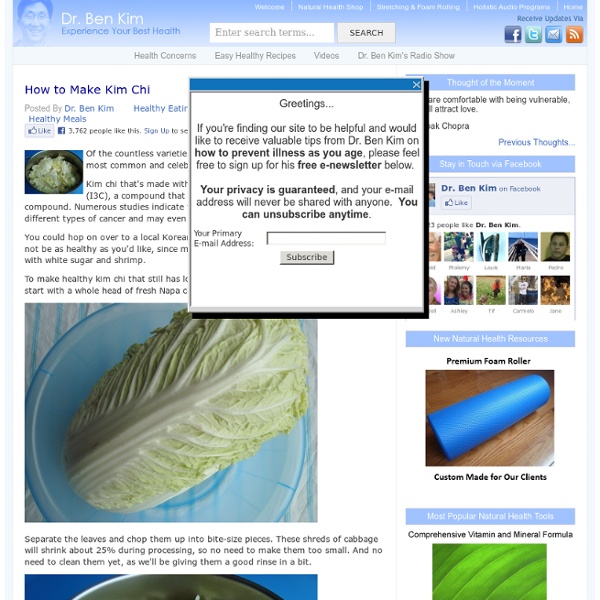How to Make Kimchi
My first encounter with kimchi was just plain offensive. My mother, a Korean pickled cabbage devotee, used to occasionally crack open a jar at the dinner table, and it was only a matter of seconds before my brother and I had our noses buried in our shirts, mumbling complaints about its malodorous air from beneath the veil of our Hanes cotton tees. Eventually, after much coercing, I dipped into the jar, only too happy to now be the one offending my younger brother’s senses. Kimchi at its most basic is a selection of pickled, often fermented, vegetables. A few notes on ingredients: Korean chile powder, known as kochukaru, AKA red pepper powder, AKA hot pepper powder, is far less spicy than its deep ruby color would have you believe. The salted shrimp is simply baby shrimp packed in a saltwater brine, and any well-stocked Asian market will carry it. This kimchi recipe can be broken down into 4 basic steps: Salting the cabbage; Making the chile paste; Prepping the vegetables; and Jarring.
How to Make Kimchi: A Step-by-Step Guide
I attended a most fabulous kimchi pickling workshop earlier this week hosted by Cham Korean Bistro, my favorite restaurant in Pasadena. The event was held at the restaurant’s R&D kitchen in the little-visited city of Vernon and was attended by all sorts of food-adoring media types including my pals B-Side, H.C., Javier, Valentina, Esther, and Eddie. We were all eager to learn the ins and outs of fermentation and to expand our knowledge of Korea’s beloved dish. Led by Chef EJ Jeong, formerly of BOA and A.O.C., the two hour-long class was fun, educational, and most importantly, tongue-searingly delicious. Before the class officially began, we were treated to a selection of small bites including tofu pockets, kale chips, and seared tuna on a stick. After we filled our bellies halfway, it was time for the learning to commence… The ingredients for the tong baechu kimchi were laid out neatly for us. For Napa cabbage 2 heads Napa cabbage2 cups sea salt8 cups water For kimchi marinade
Bok Choy Kimchi | Beyond Kimchee
“Banana?” I was quite stunned when I heard one Korean mom mentioned this everyday fruit. I was at lunch with a bunch of Korean ladies for school related gathering and we were talking about making Kimchi with local vegetables in Malaysia. I’ve known about making Kimchi with Bok Choy, the famous Chinese vegetable, but adding banana in Kimchi?… that is simply outrageous. I’ve been eating bananas all my life but the idea of connecting the banana with kimchi never – ever came across to my mind! Well, if you think about it, banana will work great in Kimchi. I was so thrilled that I had to grab some Bok Choy and a bunch of banana on the way home. The result? It is quite awesome.., both in taste and texture-wise. Grab some of these beautiful Bok Choy. Cut in half or quarter lengthwise depends on their size. Rinse them gently to remove dirt or anything impure. Place 1/3 of Bok Choy brothers in a large shallow bowl and sprinkle 1/3 of Korean coarse sea salt evenly over. Repeat the layers. Go, bananas!
Basic Napa Cabbage Kimchi (Kimchee) Recipe
I don't bother with the soak for 12 hours, rinse, then combine remaining ingredients bit. I combine all ingredients and pack tightly, adding a teeny bit of vinegar if there isn't enough liquid to cover the veggies. I put a weight on top to help ensure that everything is completely covered in liquid. And I don't use that much salt for my recipe - I don't measure, but it's probably around a tablespoon or so of salt for that amount of cabbage. I just taste and as long as it tastes right, like a nice bowl of salty soup, then that's about right. If I'm using head cabbage, which is much tougher, the husband will smash it a bit to help release the liquids in the cabbage. There's no real hard and fast recipe for kimchi - it's made a whole lot of different ways depending on personal preferences. We love kimchi.
Kimchi Recipe
If I had to name my favorite cuisine, it would be a toss-up between Vietnamese and Korean. Both offer charbroiled meats, pickled or marinated vegetables, and a lively and sometimes spicy array of seasonings. What’s not to like? Most unfamiliar ethnic foods become instantly accessible if you take a trip to a local shop to stock up on a few specific ingredients. Ok, and a nice hunk of pork shoulder as well. Every time I go to a specialty market, whether it’s Mexican, Japanese, or Chinese, I invariably lug back bottles of vinegars, odd herbs, specialty sugars and some sort of backside-burning chili pastes home with me. It was a little strange: unlike the usual voices I hear in my head, this one had a Korean accent. Then yet another voice chimed in and reminded me that I’d bookmarked a recipe that Aun at Chubby Hubby made: the most amazing-looking Vietnamese Pork Ribs in Caramel Sauce from Molly Steven’s book All About Braising. But I couldn’t find any. Zip. Related Posts and Recipes Jook



